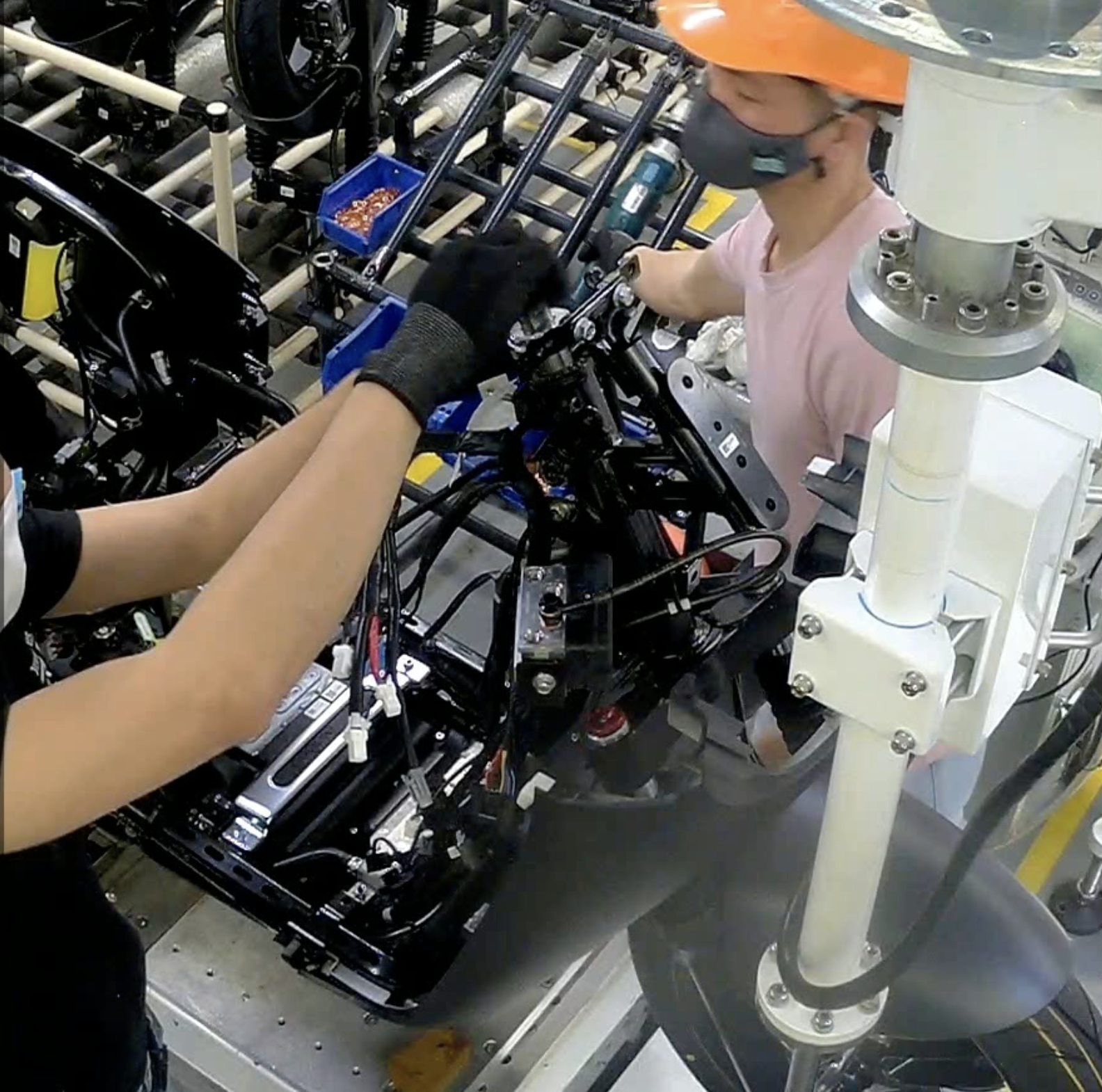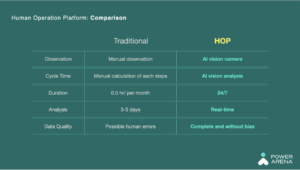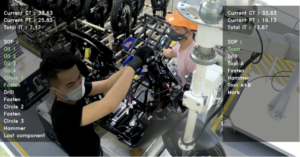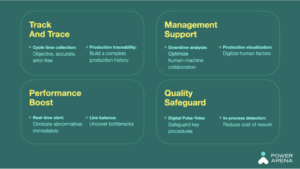Case Study
HOP Joins the Future of EV Production.

The Future of Manufacturing: The Gap between Imagination & Reality
While full automation may seem like an imminent future for the manufacturing industry, contrary to common belief, “human” involvement continues to play a significant and irreplaceable role in the majority of assembly line production.
In today’s high-mix, low-volume production environment, the manufacturing industry relies heavily on human coordination, cognition, adaptability, and flexibility due to the frequent changes in production lines. It is this flexibility that enables us to outperform technology. Technology is a valuable tool that simplifies human work.
Nevertheless, it is this very flexibility in human behavior that leads to significant variability, making the management of workers a challenging task.
The Missing Piece in Factory Management
Traditional production line management relies on industrial engineers stationed next to workstations, making visual observations, and manually recording work hours with stopwatches. They later analyze the data, identify influencing factors, and propose hypotheses to enhance line production. However, this approach is complex, time-consuming, and incomplete. The data obtained may contain inaccuracies due to subjective errors in judgment. Furthermore, implementing improvements lacks timeliness, and making immediate adjustments can be challenging.
Within the five elements of 4M1E quality management, “humans” present the most challenging aspect to manage and are a major source of problems. Human uncertainties arise from factors like negligence, emotions, physical condition, operational skills, and more. These “causes of inefficiency and low quality” pose significant management challenges. Traditional management methods make it challenging to obtain data on human movements and ensure consistent production quality. Despite manufacturers’ efforts to embrace digital transformation, effectively managing “humans” remains the missing piece of the factory management puzzle.
AI vision fills this gap.

Smart Factory Upgraded Again
The purpose of AI vision is to aid production line managers in optimizing manpower allocation for more valuable tasks. In the past, Industrial Engineering (IE) engineers used stopwatches on the production line to record work time at each workstation. However, this approach was highly time-consuming, requiring around 24-48 hours of study for each product, but yielding only about 15 minutes of production line data per month. Moreover, the stopwatch recordings provided data without any visual information, making it challenging to identify the root causes of significant time differences between workstations or operators. Consequently, addressing and resolving these issues effectively proved difficult. Additionally, the collection of production line data was a tedious and repetitive task, often neglected by IE engineers due to other urgent responsibilities, resulting in incomplete data records.
Thanks to the latest AI visual analysis upgrades, AI vision has become an effective tool for managing the workforce and handling significant variations caused by human factors. It enables better control and proves to be invaluable in optimizing operations.
Gogoro Production Line
Over the years, Gogoro has focused on creating an exceptionally advanced EV assembly line. They have continuously implemented cutting-edge technologies such as MES, IoT, and more recently AGVs to optimize their industry-leading EV production line. The result is a highly flexible operating station with an excellent balance between human and machine involvement. This setup heavily relies on human operators who play a crucial role in both the output volume and quality control of the assembly line.
A specific case had been causing resource drain for Gogoro in managing and operating their production. A lack of supervision had led to some of the procedures being susceptible to inspection issues. To address this problem and close the data gap related to “human movements” and “unconnected tools”, Gogoro actively sought solutions to identify the root causes of inefficiency and quality issues in their operations. In this endeavor, PowerArena’s AI Vision platform, specifically the Human Operation Platform (HOP), becomes crucial. It offers the necessary tools and technology to pinpoint the underlying issues and provide valuable insights into the production processes.
Ensuring In-Process Quality Control for Layer-by-layer Assembly
At the parallel stations dedicated to the front wheel bracket, two operators work together on opposite sides of the electric scooter, using a wide variety of tools. A critical step in the process involves applying oil before closing the enclosure. However, once the enclosure is sealed, the areas where the oil is applied become hidden, making it virtually impossible to verify whether the oil application has been completed.
Thanks to HOP’s motion analysis, the process of oil brushing can now be verified in real time. AI vision is used to safeguard critical work steps. By combining this with video footage, management gains the ability to trace back to any specific point in the production process.

Flexibility Brings Variability: Production Line Footage Tracking and Tracing
Another unexpected abnormality stems from workers’ attempts to speed up production by taking shortcuts.
Gogoro’s internal management system captured a cycle time that differed by a few seconds compared with the data detected by AI vision. Upon analyzing the footage recorded by AI vision, it became apparent that the SOP was not followed correctly. The system’s completion button was supposed to be pressed after fastening two screws, but the worker, for ease of movement, pressed the button after the first screw was fastened, before moving on to the second one. This discrepancy led to the numbers on the MES system differing from the accurate numbers captured by AI vision.
Before HOP’s AI vision, it was impossible to detect the error by looking at the numbers and finished products alone because the process was complete, just not in the correct order. The only way to make this small discrepancy visible was to trace back the AI footage, which enhanced the reliability of captured data.
Zero Defect Rate
Unlike electronic products, faulty vehicles can remain undetected until much later. Noises or operating irregularities may only start to appear after they have been on the road for a considerable period of time. Typically, the issues are identified during inspections, which often require disassembly to uncover the problem. Beyond the risk to user safety, manufacturers also have to deal with the substantial costs of remediation and negative effects on their reputation.
In the automotive assembly industry, achieving high quality and precision while eliminating all defects in the manufacturing process is crucial. When AI vision detects an abnormality in Gogoro’s production line, the AGV carrying the electric scooter will promptly come to a stop and notify the manager. The work in process will remain at the station until the manager confirms that all the identified mistakes have been rectified. Implementing these in-station corrections incurs minimal costs compared to the potentially significant expenses associated with remedial actions in the future.
After HOP was introduced into Gogoro’s production, product yield successfully reached 100%. HOP’s AI vision prevented all defective products from leaving the station.
Advancing to the Next Level: Smart Factory Upgrades
AI vision aims to simplify managers’ work, enabling them to unleash their full potential. It serves as a game-changer when it comes to upgrading and effectively managing various aspects of manufacturing operations. Tasks that once required a significant amount of time from industrial engineers, such as measurement operations, can now be streamlined effortlessly with through AI vision implementation. Moreover, AI vision has the capability to uncover hidden problems that are otherwise difficult to monitor. This is especially beneficial for assembly stations, which are known for their quality control challenges. By leveraging AI vision, managing the intricate variability of human factors becomes an efficient and effective practice.
AI Vision: Digitization as a Solution

Capture 24/7 Production Data
HOP replaces the conventional manual monitoring approach with an objective and precise system that continuously captures cycle time through real-time video analysis, offering a reliable record of operations through AI vision. It excels at identifying unusual cycles and equipping managers with comprehensive data to optimize the performance of production lines.
Video Track and Trace. Production Visualization.
With HOP, you can examine the state of any workstation at any point of production to uncover hidden problems and locate the root causes of inefficiencies. This allows managers to concentrate on important matters and tackle the issues that have the greatest impact. HOP also supports data analysis for situations like machine failures, material shortages, or employee changes.
Real-Time Alert Digital Poka-Yoke
HOP sends out alerts immediately when abnormalities occur. Managers will be notified whether the problems stem from equipment malfunction or operators deviating from specific SOPs. At key workstations, the procedures can be checked in real time, ensuring seamless integration with MES to swiftly identify deviations. These proactive measures prioritize personnel safety and product quality, quickly resolving issues and significantly reducing the costs associated with investigations, speculations, rework, and waste disposal.
About Us
About PowerArena
With world leading manufacturing AI vision system—Human Operation Platform, PowerArena was deemed the most strategically competitive brand by Frost & Sullivan in 2022. 60% of the global top 5 EMS providers now have HOP live in their factories across multiple continents. PowerArena is the most advanced manufacturing AI software company funded by ex-Googler and now with locations all around the world in North & Central Americas, Taiwan, Hong Kong and China.
HOP (Human Operation Platform)
PowerArena’s Human Operation Platform (HOP) is an advanced smart manufacturing solution driven by AI. HOP visualizes operations on labor-intensive production lines, providing real-time and transparent information. HOP features 24/7 data collection, AI vision analysis and full traceability. Applications include SOP compliance, line balance, and in-process quality control. HOP harnesses useful data and provides insights into production optimization.
